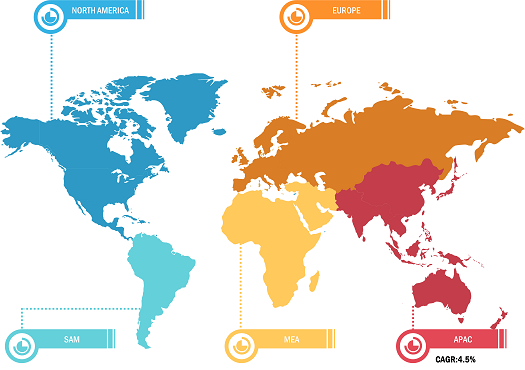Rising Adoption of Chlorine from End-Use Industries Bolsters Chlorine Market Growth
According to our latest study on “Chlorine Market Forecast to 2030 – COVID-19 Impact and Global Analysis – by Application and End-Use Industry,” the chlorine market size was valued at US$ 19,988.92 million in 2022 and is expected to reach US$ 26,777.66 million by 2030; it is estimated to register a CAGR of 4.1% from 2022 to 2030. The report highlights key factors driving the chlorine market growth and prominent players along with their developments in the market.
Chlorine Market Breakdown – by Region
Chlorine Market Forecast to 2030 - Global Analysis by Application (Ethylene Dichloride/Polyvinylchloride Production, Chloromethanes, Isocyanates & Oxygenates, Solvents, and Others) and End-Use Industry (Water Treatment, Chemicals, Pulp & Paper, Plastics, Pharmaceuticals, and Others)
Chlorine Market Key Findings and Share by 2030
Download Free Sample
Chlorine is one of the most widely used disinfectants in water treatment due to its effectiveness in destroying harmful microorganisms and ensuring safe and potable water delivery to communities. The process of chlorination involves adding chlorine or chlorine-based compounds to water to destroy bacteria, viruses, and other pathogens that may pose a health risk to consumers. Using chlorine in water treatment has been crucial in improving public health and preventing waterborne diseases such as cholera, typhoid, and dysentery. Chlorine acts as a potent oxidizing agent when dissolved in water, and it readily reacts with organic matter and microorganisms. It also oxidizes and breaks down organic compounds, helps reduce unpleasant tastes, odors, and colors in water. In addition, it plays a critical role in the production of polyvinyl chloride (PVC), one of the widely used thermoplastics. PVC manufacturing relies on chlorine for various applications, including synthesizing different plastics and related compounds. PVC is made by polymerizing vinyl chloride monomers (VCM) derived from ethylene chlorination obtained from petroleum feedstocks. The chlorination process converts ethylene into vinyl chloride monomers, which are polymerized to form PVC resins. Plastic has applications in construction, automotive, electrical, healthcare, and many other industries due to its excellent properties, such as durability, chemical resistance, and cost-effectiveness. Thus, the high demand for chlorine from different end-use industries is contributing to the chlorine market growth.
Aditya Birla Chemicals India Ltd, BASF SE, Ercros SA, Hanwha Solutions Corp, INEOS Group Holdings SA, Occidental Petroleum Corp, Olin Corp, Tata Chemicals Ltd, Vynova Belgium NV, and Sumitomo Chemical Co Ltd are among the players operating in the global chlorine market. The global chlorine market players focus on providing high-quality products to fulfill customer demand.
Impact of COVID-19 Pandemic on Chlorine Market
The COVID-19 pandemic has adversely altered status of the chemicals & materials sector and negatively affected the chlorine market growth. The implementation of measures to combat the spread of SARS-CoV-2 has aggravated the situation and declined the growth of various industries. As a result, there was a sudden distortion in operational efficiencies and disruptions in the value chains; many industries faced several challenges owing to the shutdown of national and international boundaries. The COVID-19 pandemic has restrained the import and export of chlorine in different countries, hampering the chlorine market growth. The shortage of chlorine due to the COVID-19 pandemic increased its prices rapidly across the world. However, several companies operating in the manufacturing industries revived their businesses owing to the ease of restrictions. Hence, the demand for chlorine is rising across the world, especially among the chemical, pharmaceuticals, water & wastewater, and PVC manufacturing sectors.
The report includes the segmentation of the chlorine market as follows:
The global chlorine market is segmented on the basis of application, end-use industry, and geography. Based on application, the chlorine market is segmented into ethylene dichloride/polyvinylchloride production, chloromethanes, isocyanates & oxygenates, solvents, and others. In terms of end-use industry, the chlorine market is segmented into water treatment, chemicals, pulp & paper, plastics, pharmaceuticals, and others. By geography, the chlorine market is broadly segmented into North America, Europe, Asia Pacific, the Middle East & Africa, and South & Central America. The North America chlorine market is further segmented into the US, Canada, and Mexico. The market in Europe is subsegmented into Germany, France, the UK, Italy, Russia, and the Rest of Europe. The Asia Pacific chlorine market is further segmented into China, India, Japan, Australia, South Korea, and the Rest of Asia Pacific. The market in the Middle East & Africa is further segmented into South Africa, Saudi Arabia, the UAE, and the Rest of Middle East & Africa. The South & Central America chlorine market is subsegmented into Brazil, Argentina, and the Rest of South & Central America.
Contact Us
Phone: +1-646-491-9876
Email Id: sales@theinsightpartners.com